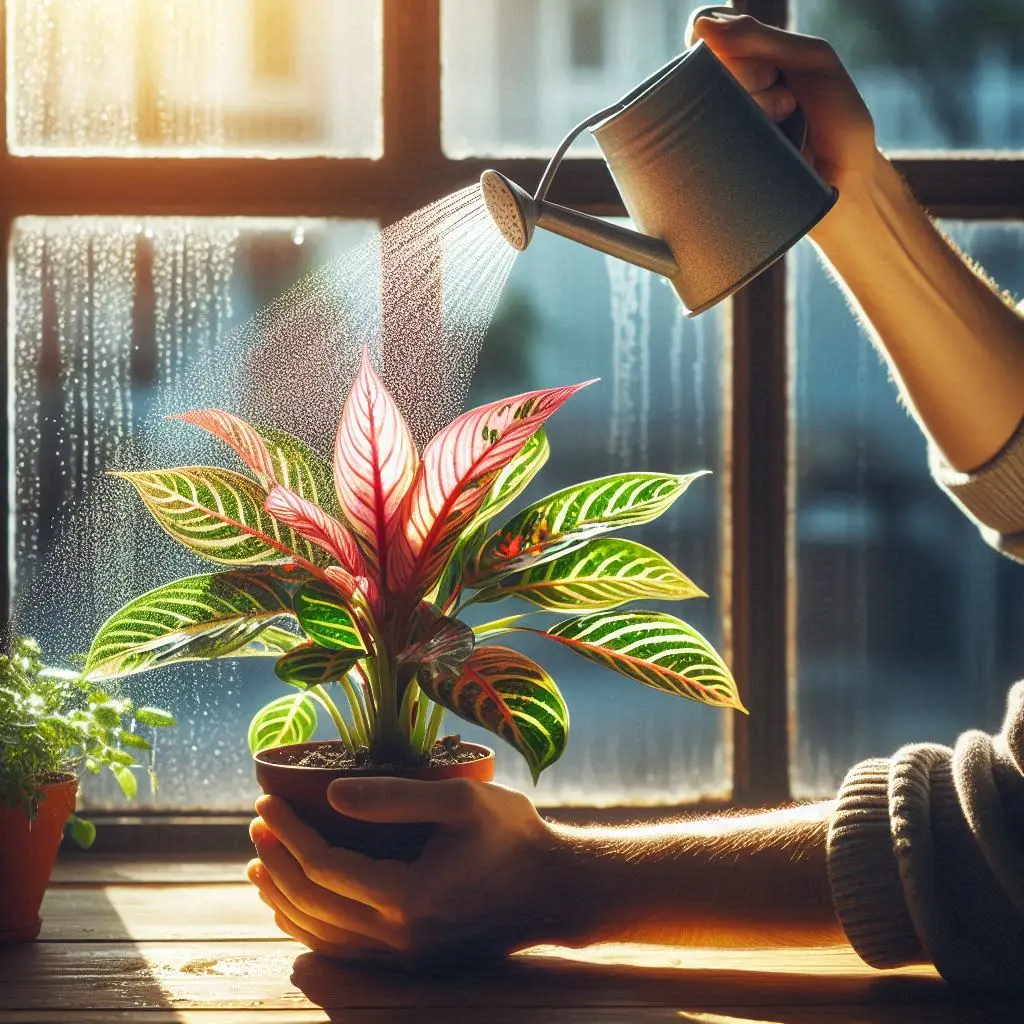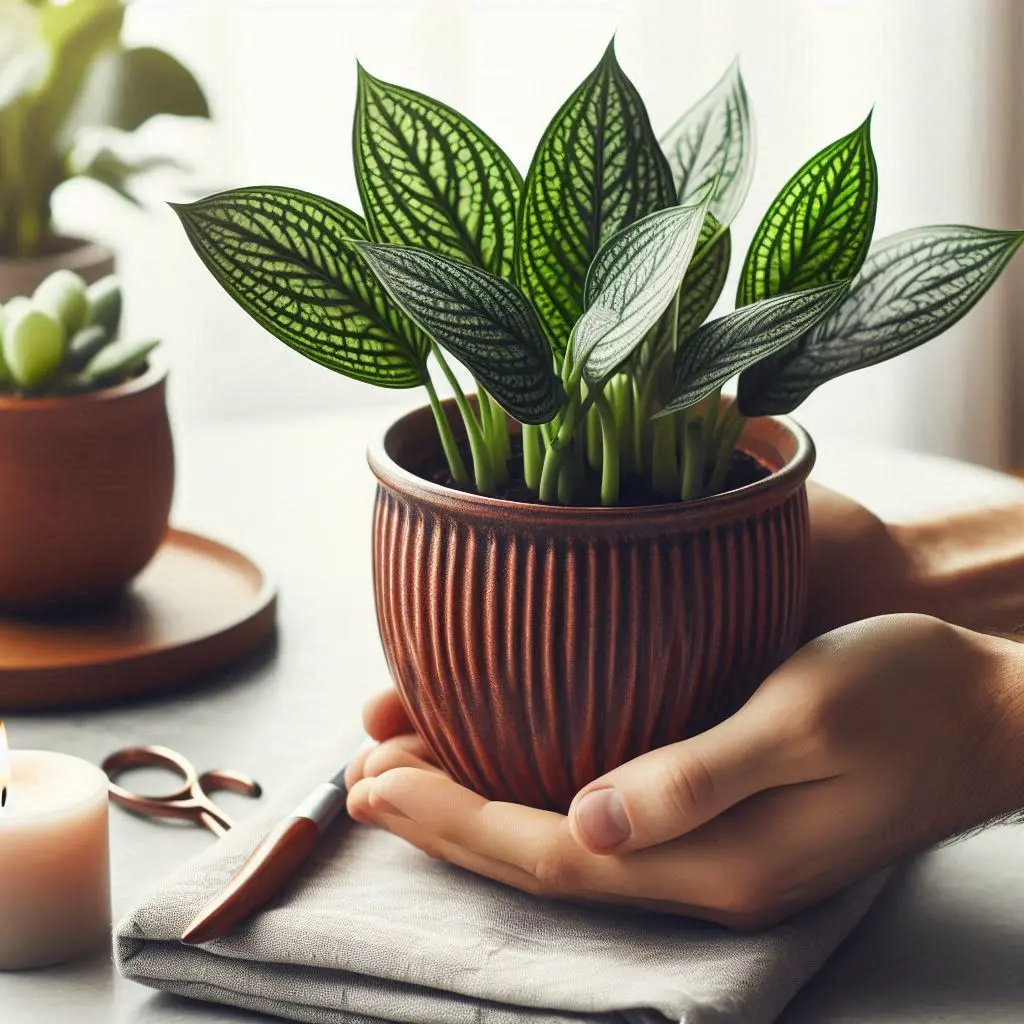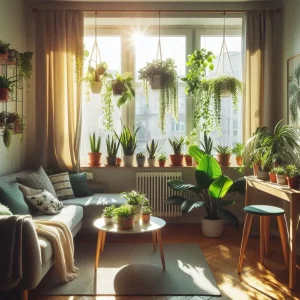Care for Maranta Plant:
Page Contents
Toggle| Tip | Description |
| Light | Provide indirect, filtered sunlight to prevent leaf burn. |
| Water | Keep soil consistently moist but not waterlogged. Avoid letting the soil dry out completely. |
| Humidity | Maintain high humidity levels by misting the plant or using a humidifier. |
| Temperature | Keep temperatures between 65-80°F (18-27°C) for optimal growth. |
| Fertilization | Feed with a balanced fertilizer diluted to half strength every 2-4 weeks during the growing season. |
| Pruning | Trim brown or yellow leaves regularly to promote new growth. |
| Repotting | Repot every 1-2 years in fresh, well-draining soil to prevent overcrowding and improve growth. |
Maranta is a slow-growing plant and (it) is suitable for small spaces. It thrives in a greenhouse-like environment with warm, humid conditions and proper ventilation and fertilization.
If placed in an environment that is too dry or cold, the plant will lose its leaves and become susceptible to fungal diseases, ultimately leading to its demise. Conversely, if exposed to excessive sunlight, the leaves may burn and develop brown spots.
read more: Best indoor garden tips that you should know!
Light:
Maranta prefers bright but indirect light. It should never be placed in direct sunlight as it can cause leaf burn or develop visible spots, causing the leaves to lose their color. This plant can tolerate low-light conditions, but in winter, it goes into a period of dormancy and should be placed in a well-lit area.
Soil:
Maranta prefers acidic soil. An excellent soil mix for this plant includes peat with a pH range of 5.5 to 6.0 or a mix of two parts peat moss, one part loamy soil, and one part perlite or coarse sand. Alternatively, regular potting soil can be used as long as it has proper drainage. If you feel the soil drainage is inadequate(not enough), you can improve it by adding perlite or coarse sand to the soil. Make sure the pot has drainage holes.
Watering:

During the growing season, from spring to early fall, it’s best to regularly water the Maranta and ensure that the soil remains consistently moist. Whenever the soil surface starts to dry out, it’s time to water, and you should not allow the soil to completely dry out. The plant quickly becomes thirsty and requires water, but on the other hand, you should also be cautious about diseases and fungi. Therefore, avoid leaving the leaves wet or the soil excessively soaked. Both underwatering and overwatering can damage the plant, causing yellowing or leaf drop. It’s better to use room temperature water and ensure it’s not cold. Also, reduce watering during the winter.
Humidity:
Maranta thrives in high humidity. You can increase humidity by misting the plant regularly, placing a humidity tray filled with water and pebbles beneath the plant, or using a room humidifier.(misting the leaves of the plant with water that temperature of it is the same of the temperature of room)
Temperature:
Maranta prefers temperatures between 65-80°F or 18-27°C (5-18°C less than this range can hurt your plant). Keep the plant away from drafts or sudden temperature changes.
Pruning:
Prune dead or yellowing leaves to maintain the plant’s appearance and encourage new growth.
Propagation:
Maranta can be propagated through division or stem cuttings. Divide the plant during repotting or take stem cuttings with at least one node and place them in water or moist soil to root.
Fertilization:
For fertilizing Maranta, you can do so every two weeks from early spring to mid-fall. It’s best to dilute a balanced fertilizer like 10-10-10 to half(twice) the recommended strength. If the fertilization is too low, the plant’s growth may slow down or become difficult. Over-fertilization can lead to root burn, leaf browning, and even plant death. Reduce fertilization to once a month during the winter.
Toxicity:
Maranta plants are not toxic to humans or pets.
Repotting:
Continuing with the care of the Maranta plant, let’s discuss how to re-pot it. This plant doesn’t need frequent repotting, but over time, its roots may overcrowd the pot, and the space may become limited, slowing down the plant’s growth.
When repotting Maranta, choose a pot that is at most 4 to 5 centimeters larger than the previous one. To repot the plant, gently remove it from the old pot, clean its roots from the old soil, and place it in a new pot with fresh soil.
The best time to repot this plant is in early spring before the growing season begins.
Propagation of Maranta:
Contrary to what may seem, propagating Maranta is easy. Some varieties can be propagated through stem cuttings or by dividing their rhizomes. However, one of the most common and easiest methods is through division during repotting.
Dividing the Roots:
Simply clean the roots during repotting and divide the plant into smaller sections. These new plantlets should each have enough roots and stems. Then, plant them separately in smaller pots and provide a very warm and humid environment for them until you see the first signs of growth.
Stem Cuttings:

Choose a stem and cut it just below a leaf node to obtain a new cutting. Dip(put) the cutting in rooting hormone and then place it in a glass container with water. Make sure to change the water every two days to prevent the formation of algae or harmful bacteria. Once you see the first signs of root growth, transfer the plant to a pot with soil, keeping both the soil and the plant moist.
Issues, Diseases, and Pests:
Diseases:
| Disease | Symptoms | Treatment |
| Leaf Spot | Brown spots on leaves, which may enlarge over time. | Remove affected leaves, improve air circulation, avoid overhead watering. |
| Root Rot | Wilting, yellowing leaves, mushy roots. | Improve drainage, reduce watering frequency, repot in fresh soil if severe. |
| Powdery Mildew | White powdery patches on leaves and stems. | Prune affected parts, improve air circulation, apply fungicide if necessary. |
One of the most common diseases affecting Maranta is leaf spot, also known as brown spot disease. If not promptly treated, this disease can quickly lead to the death of the plant. Overwatering is often the cause, and adjusting the watering frequency can help control this problem.
Yellowing of the leaves is another issue that occurs in Maranta care. This problem usually occurs due to poor growing conditions, fungal diseases, or viruses. Often, the cause of leaf yellowing is something that can be controlled, such as the plant’s location or fertilization levels. However, sometimes more serious action may be necessary.
The first step when leaves start yellowing is to check the lighting conditions. If the plant is receiving too much light, move it to a spot with indirect, filtered light.
High levels of phosphates and fluorides in the water can also cause the edges of the leaves to burn. It’s better to use filtered water or let the water sit for a while to allow the salts to settle.
Chlorosis is another reason for leaf yellowing, usually occurring in young leaves. The cause is an iron deficiency in the plant, and if left untreated, it can lead to the plant’s death. If the soil pH is very high or overly compacted, chlorosis may occur. Soil that is too compact and wet retains more phosphorus, resulting in less iron availability. Adding iron supplements can help solve this problem.
Cucumber mosaic virus is another disease that causes leaf yellowing in Maranta. If yellow spots appear on the leaves while the green parts remain healthy, your plant may be infected with this virus. You may notice that new leaves are smaller and weaker, and old leaves have yellow streaks on them. Unfortunately, there is no cure for cucumber mosaic virus, and it’s best to dispose of the infected plant to prevent the spread of this disease to other plants.
Pests:
Like any other plant, Maranta is susceptible to pest infestations.
The most common pest that attacks this plant is spider mites. These insects live among the stems and leaves of the plant, but fortunately, they don’t thrive in high humidity. Since Maranta performs well in high humidity, you can prevent these pests by increasing the humidity level.
Detecting spider mites is not easy, and you may only see the white webs they leave behind. However, these small insects can still halt(stop) the plant’s growth. You can combat these pests by using predators like ladybugs or applying neem oil.
Mealybugs are another pest that affects Maranta. These insects leave behind a white, cotton-like substance. They usually hide among the stems and leaves, sucking the plant’s sap and reproducing rapidly. When you notice these pests, quarantine the plant to prevent them from spreading to other plants. Then, create a mixture of three-quarters water and one-quarter alcohol with a few drops of dish soap and clean the affected areas with a clean cloth. Repeat this process after a few days. You can also use commercial(industrial) insecticides or neem oil.
Know the most common pest in Maranta, quoted by PLNTS:
Like many houseplants, Maranta plants are susceptible to spider mites and mealybugs. If you see a white powdery substance on the leaves or brown discolouration, you can use a natural insecticide like neem oil solution to get rid of them.Keep a close eye on your Maranta, and if in doubt, visit our PLNTS doctor page. This will help you determine which pests are bothering your plant and how to best combat them.
Final Words:
In this article, we’ve tried to explain everything you need to know about caring for Maranta plants. If anything has been left unsaid or if you have any questions requiring specialized advice on your plant, you can ask your questions through online plant consultation with Gulistan Plant Medicine. Our experienced plant medicine specialists are ready to answer your questions. They will examine your plant’s problem and, if necessary, provide you with plant food (fertilizer), pesticides, and other plant necessities. Additionally, if you don’t have enough time or expertise to care for your plant, you can utilize our on-site plant and garden services. Our specialists will come equipped with the necessary tools to provide services such as disease diagnosis, troubleshooting, soil and pot replacement, pesticide application, fertilization, planting, and more at your location.







